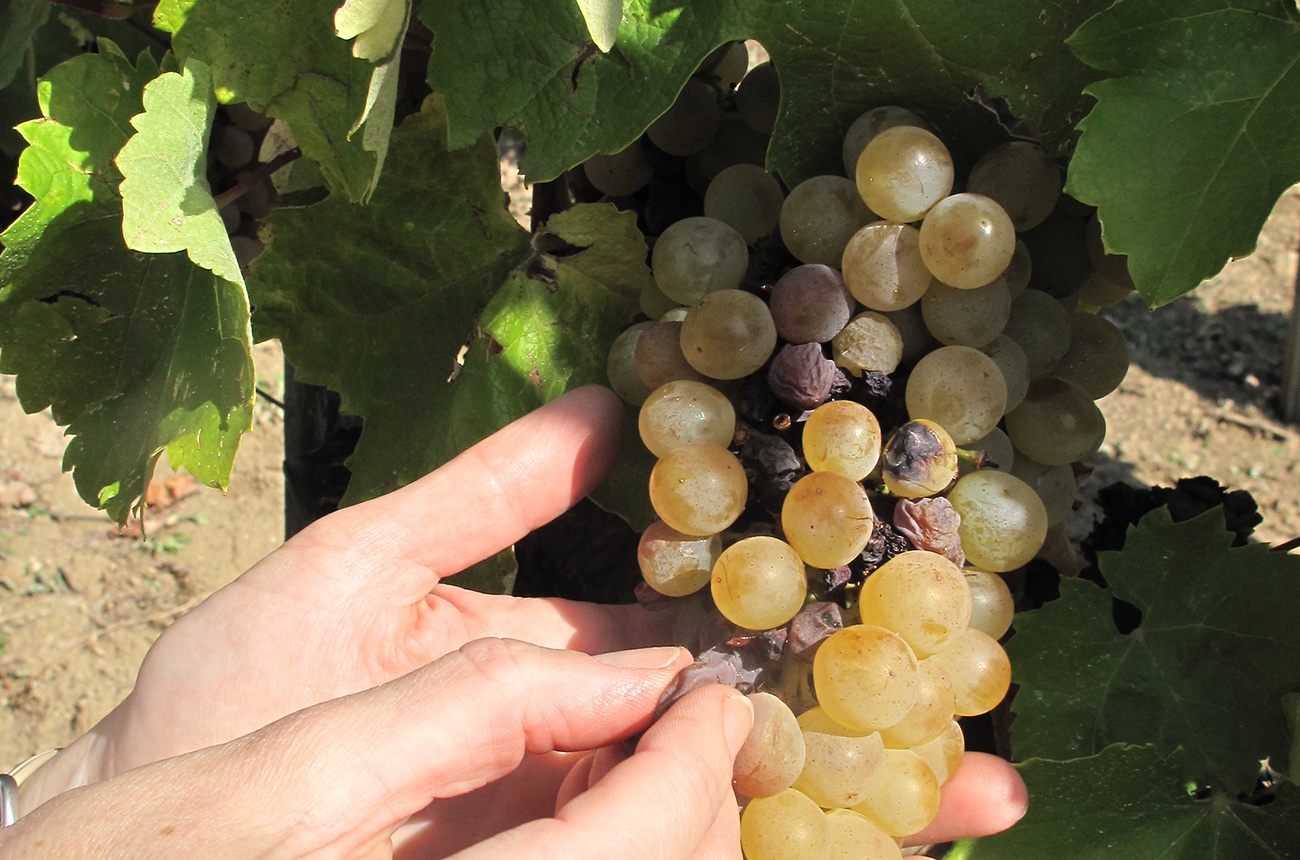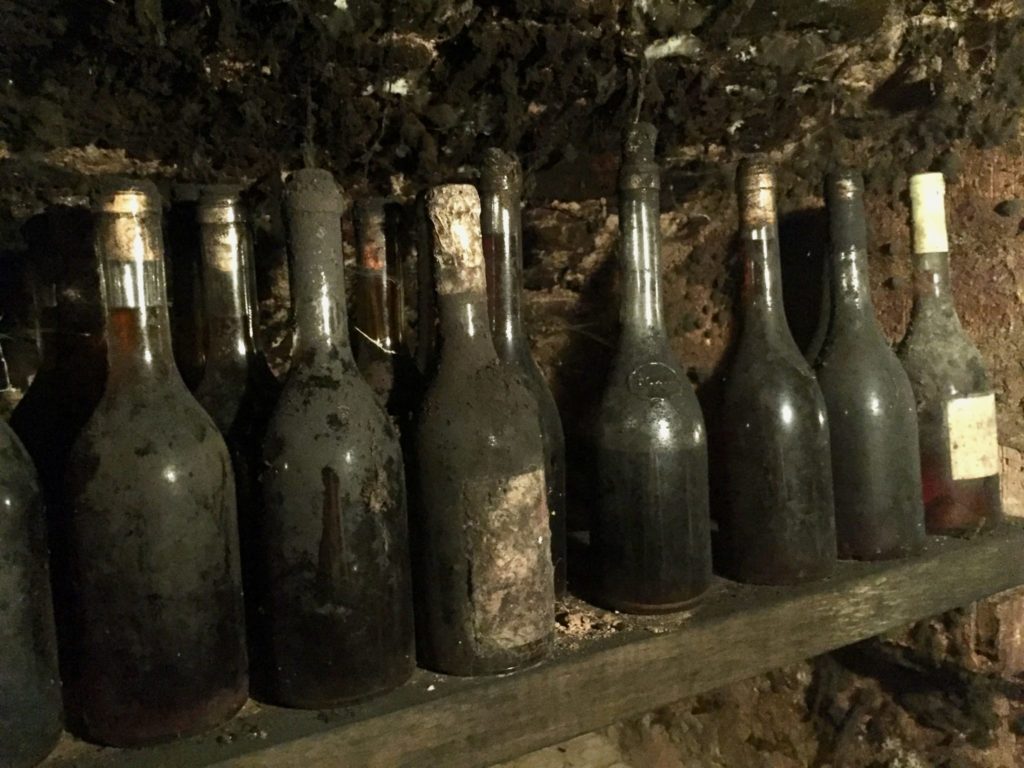Tokaji means “from Tokaj” and is used to describe most of the wines from a town in Hungary and the country’s most famous wine region. Located in the northeast part of the country which is volcanic. The humid climate in Tokaj encourages the growth of botrytis cinerea (noble rot).

Health Benefits
Tokaji Wine has a number of health benefits that have been clinically proven due to the given volcanic regions it is grown in and through the botrytization process. It is true that there is scarcely any other wine so rich in minerals and penicillin as Tokaji, so much so that in the first half of the 20th century aszú wines were available in pharmacies and sold as medicine. Tokaji was used as a remedy especially for anemie. As a matter of fact, the Tokaj wine’s content of the vitamins B, E, and the “happiness hormone” serotonin is partially significant higher than in other wines. Furthermore, good Tokaj wines contain a comparatively high amount of constitutional substances such as superoxide dismutase (SOD), resveratrol, polyamines and polyphenols, which reduce oxidative stress in the organism in their role as antioxidants. Thus they help decreasing the risk of cancer and cardiovascular deseases. Similar to the red wines, the Tokaj wine’s high content of polyphenols is a result of leaving the grape’s paring with the mash for several hours, before being pressed.

Highest Antioxidants in Wine

Compounds with Antiviral, Anti-Inflammatory and Anticancer Activity Identified in Wine from Hungary’s Tokaj Region via High Resolution Mass Spectrometry and Bioinformatics Analyses
| Compound Name | Role, Biological Activity |
|---|---|
| Achalensolide | NF-κB inhibitory activity in Jurkat T cells |
| DL-alanyl-DL-phenylalanine | Cytotoxic effect against aggressive human metastatic breast adenocarcinoma MDA-MB-231 and MCF-7 cells |
| Asperlin | Induction of apoptosis via ROS production in human cervical carcinoma HeLa cells Inhibition of iNOS, suppression of COX-2 expression, reduction in COX-derived PGE2 |
| Bestatin | Antiviral activity against coronaviruses |
| Caffeic acid | Anticancer activity against human cell lines originating from breast cancer (MCF-7, MDA-MB-231) cervical cancer (HeLa), metastatic cervical cancer (SiHa), hepatocellular carcinoma (HepG2, Huh7), lung cancer (A-549), colon carcinoma (HT29-D4, HCT 15), melanoma (SK-Mel-28), oral squamous cell carcinoma (SCC-25), gastric cancer (SCM1), suppression of UVB-induced skin carcinogenesis Reduction in lipid peroxidation and of TNF-α, IL-6, IL-1β, IFN-γ, NF-κB/p65 and TGF-β levels |
| Dimethylcaffeic acid | Antiviral activity against HBV, HIV-1 Anticancer activity against cancer cell lines: human hepatocellular carcinoma BEL-7404 and HepG2, SK-OV-3 human ovarian cancer, human breast MCF-7 adenocarcinoma, human lung A549 adenocarcinoma and human gastric cancer BCG823 Suppression of NF-κB activation and its downstream inflammatory mediators, iNOS, COX-2, and PGE2 |
| (E)-Ethyl caffeate | Antiviral activity against HBV, HIV-1 Anticancer activity against cancer cell lines: human hepatocellular carcinoma BEL-7404 and HepG2, SK-OV-3 human ovarian cancer, human breast MCF-7 adenocarcinoma, human lung A549 adenocarcinoma and human gastric cancer BCG823 Suppression of NF-κB activation and its downstream inflammatory mediators, iNOS, COX-2, and PGE2 |
| Chlorogenic acid | Anticancer activity against human cell lines originating from breast cancer (MCF-7, MDA-MB-231), cervical cancer (HeLa), hepatocellular carcinoma (HepG2), lung cancer (A-549), colon carcinoma (CT-26, Caco-2, HT29-D4, HCT 116), melanoma (SK-Mel-28), oral squamous cell carcinoma (HSC-2), salivary gland cancer (HSG), pancreatic cancer (PANC-1), leukemia (U937, HL-60, K562), prostate cancer (DU145) Anti-inflammatory activity, inhibition of NO and proinflammatory cytokine production |
| Coumarin | Coumarin derivatives exert anti-coagulant, anti-tumor, anti-viral, anti-inflammatory and antioxidant effects, as well as anti-microbial and enzyme inhibition properties Anticancer activity against human cell lines originating from gastric carcinoma, colon-carcinoma cell line (Caco-2), hepatoma-derived cell line (HepG2), lymphoblastic cell line (CCRF CEM), lung adenocarcinoma (A427, Calu-1, SK-MES-1, SK-LU-1), renal carcinoma (786-O, A-498), malignant prostatic cancer (DU145, LNCaP), beneficial effects in renal cell carcinoma and malignant melanoma |
| (E)-p-coumaric acid | Antiviral activity against oseltamivir- and peramivir-sensitive and oseltamivir- and peramivir-resistant influenza viruses and hepatitis C Anticancer activity in mammalian, colon and hepatic cancer and neuroblastoma cell lines Inhibition of the STAT1 activation, decrease in TNF-α expression, ROS scavenger function |
| Cyclo(phenylalanyl-prolyl) | Growth inhibition and apoptosis induction in HT-29 colon cancer cells |
| Dehydrocostus lactone | Inhibition of Norovirus infection Anticancer activity against human cell lines originating from ovarian cancer (SK-OV-3), breast cancer (MCF-7, MDA-MB-231), cervical cancer (HeLa), hepatocellular carcinoma (HepG2), lung adenocarcinoma (A-549, NCI-H520, NCI-H460), prostate cancer (DU145), sarcoma (liposarcoma–SW-872, synovial sarcoma – SW-982, TE-671 – rhabdomyosarcoma), neuroblastoma (IMR-32, NB-39, SK-N-SH, LA-N-1) Reduced production of chemokines induced by TNF-α and IFN-γ |
| Dodecanedioic acid | Cytotoxic effect on B16 melanoma cells |
| Eicosapentaenoic acid | Growth inhibition effect on colon cancer cell lines (HT-29, Caco-2, DLD-1), antiproliferative effects on hepatoma (HepG2), leukemia (HL-60) cell lines, inhibition of macrophage-induced gastric cancer cell migration Attenuation of pro-inflammatory properties of VLDL via decrease in lipoprotein-lipase activity to hydrolyze VLDL |
| Ethyl gallate | Anti-herpes simplex virus type 1 activity Anticancer activity against human cell lines originating from leukemia (HL-60), prostate cancer (PC-3), human (MCF-7) and mouse (S115) breast cancer, osteosarcoma (HOS-1), ovarian cancer (OVCAR-3), renal cancer (A-498), lung cancer (NCI-H460), colon cancer (KM20L2) and melanoma (SK-MEL-5) Inhibition of LPS induced cell adhesion molecules expression, attenuation of acute lung injury |
| Fertaric acid | Hepatoprotective effects |
| 16-Heptadecyne-1,2,4-triol | Cytotoxic activity in human lung carcinoma (A-549), mammary adenocarcinoma (MCF-7), colon adenocarcinoma (HT-29), kidney carcinoma (A-498), pancreatic carcinoma (PaCa-2), prostate adenocarcinoma (PC-3) cell lines |
| L-Histidinol | Pro-apoptotic activity in CCRF-CEM human leukemia cell line, inhibition of B16 melanoma cell proliferation |
| Indole-3-carbinol | Promotion of apoptosis of Epstein–Barr virus (EBV)-positive but not of EBV-negative Burkitt’s lymphoma cell lines Anticancer activity against human cell lines originating from various cancer types such as prostate cancer (LnCaP, PC-3), breast cancer (MCF7, MDA-MB-468, MDA-MB-231, HBL100), colon cancer (HT-29, HCT-116), lung cancer (A-549), cervical cancer (CaSki, SiHa, C33-A), melanoma (SK-MEL-2, SK-MEL-5), ovarian cancer (SK-OV-3), oral squamous cell carcinoma (SCC2095, SCC9, SCC15), hepatocellular carcinoma (HepG2, Huh-7, SNU449), pancreatic cancer (BxPC-3, Mia Paca-2, PL-45, AsPC-1, PANC-1), leukemia (U937, HL-60, K562, BCP-ALL NALM-6), osteosarcoma (U2OS) etc. Reversal of liver fibrosis, reduction in hepatocyte degeneration, necrosis, promotion of hepatic stellate cell apoptosis, anti-inflammatory effects by inhibiting the productions of NO, TNF-alpha, and IL-10 |
| Kynurenic acid | Modulation of IL-23 and IL-17 expression in dendritic cells and Th17 cells |
| Linamarin | Cytotoxic effects on MCF-7, HT-29 and HL60 cell lines |
| Melatonin | Indirect support against Ebola virus infection, Potential adjuvant treatment in COVID-19, and other viral infections Upregulation of Fas/Fas ligand in Ewing’s sarcoma cells, cell cycle arrest and apoptosis in hepatocarcinoma HepG2 cell line, induction of pro-apoptotic signaling pathway in human pancreatic carcinoma cells, anticancer activity in breast cancer (MCF-7) cells, inhibition of the proliferation and invasion of glioma cells, lung adenocarcinoma (A-549) cells, inhibition of estrogen receptor transactivation in breast cancer cells, negative mitogenic hormonal regulator of human prostate epithelial cells Decreases serum and tissue inflammatory cytokines levels, tissue lipid peroxidation and neutrophil infiltration |
| 9S,13R-12-Oxophytodienoic acid | Induces growth arrest in MDA-MB-231 and T47D breast cancer cells followed by progressive reduction in cyclin D1 expression Suppression of NF-κB, inhibition of p38, and activation of SOCS-1 signaling |
| Perlolyrine | Antiproliferative activity against human stomach cancer cell lines |
| Phytosphingosine | Induction of apoptotic cell death via caspase 8 activation and Bax translocation in human cancer cells |
| Quercetin | Induction of apoptotic cell death via caspase 8 activation and Bax translocation in human cancer cells |
| (-)-Rhododendrin | Inhibition of toll-like receptor-7-mediated inflammation |
| Sphinganine | Anticancer activity against human cell lines originating from leukemia (HL-60), prostate cancer (PC-3, LnCaP), breast cancer (MDA-MB-231), colon cancer (HT-29, HCT-116) and melanoma (939, 294, C8161, A2058), oral squamous cell carcinoma (SAS, Ca9-22, HSC-3) |
| Taxifolin | Antiviral activity against HIV-1, coxsackieviruses B4, hepatitis A Anticancer effect due to Nrf2, inflammatory and Wnt/β-catenin cascade modulation, inhibition of breast cancer MDA-MB-231 and 4T1 cell proliferation, cell cycle arrest in human colorectal cancer HCT116 and HT29 cells, activation of apoptosis in prostate carcinoma DU145 cells Antioxidant and anti-inflammatory effects by inhibition of NO and PGE2 production, ICAM-1, COX-2 and PLA2 expression |
| Tetrahydroharman-3-carboxylic acid | Inhibition of nitric oxide and prostaglandin E2 production |
| Umbelliferone | Antiviral activity against HIV-1 Cytostatic activity in human malignant cell lines A549, ACHN, Caki-2, Dakiki, HS-Sultan, H727, HCT-15, HL-60, K562, LNCaP, PC-3, Du 145 COLO-232, MCF-7 and RP-1788; stimulation of apoptosis in HL-60 cells, Growth inhibition of human bladder carcinoma E-J cell line, lung adenocarcinoma A-427 cells, proliferation inhibition of gastric carcinoma, colon-carcinoma (Caco-2), a hepatoma-derived (HepG2), and a lymphoblastic cell line (CCRF CEM), chemoprotective effect in early-stage (Ln- Cap) and late-stage (PC3) prostate cancer cells Anti-inflammatory and antipyretic effects, reduction of IL-4, IL-5 and IL-13, suppression of Th1 cytokine production during influenza virus infection |
| Zedoarondiol | Inhibition of iNOS, COX-2 activity and of the production of NO, PGE2, TNF-alpha, IL-6, and IL-1beta |
Research Summary
PubChem Chemical Analysis
In this study, 12 wine samples were analyzed with data-dependent mass spectrometry acquisition using both positive and negative polarity modes in order to examine the different wine components. After data evaluation, 288 components were identified based on the acquired MS/MS spectra (Table Above). Based on the literature mining, 253 components were not reported in wines previously and these novel wine components were highlighted in Table Above. The identified compounds were subjected to comparative analysis.


Research Findings
Conclusion: Health Elixer
In recent years, products of grapes have received great interest due to the discovery that several of their components have beneficial health effects on the human metabolism. While grapes naturally are carbohydrate-rich fruits, Tokaji Grapes have a glycemic index that is quite healthy. The noble rotten grape berries have high sugar content and unique chemical composition of acids, polyphenols and aroma compounds. Furthermore, the polyphenol levels in Tokaji Grapes are relatively high and studies suggest the benefits of the polyphenol content of Tokaji Grapes and Tokaji products in the prevention or treatment of cardiovascular diseases, diabetes, and cancer. Despite the great variety of fermented drinks made from fruits, Tokaji Wine is one of the best sources of antioxidants found among any grape in the world.
The Healthiest Wine
Health Benefits
Tokaji Wine has a number of health benefits:
- Supports Cardiovascular Health: Tokaji wine is rich in antioxidants, which can help reduce inflammation and oxidation in the body, improving heart health.
- Improves Digestion: Tokaji wine is known to help with digestion, as it contains pectin, a type of fiber that helps the body break down food.
- Boosts Immune System: The antioxidants in Tokaji wine can help protect the body from free radicals that can cause disease and illness.
- Enhances Skin Health: Tokaji wine is high in resveratrol, an antioxidant that can help protect skin cells from damage and reduce signs of aging.
- Reduces Stress: Tokaji wine can help reduce stress, as it contains a compound called tryptophan, which helps to relax the body and mind.

